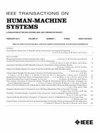Head-Pose Estimation Based on Lateral Canthus Localizations in 2-D Images
IF 3.5
3区 计算机科学
Q2 COMPUTER SCIENCE, ARTIFICIAL INTELLIGENCE
引用次数: 0
Abstract
Head-pose estimation plays an important role in computer vision. The head-pose estimation aims to determine the orientation of a human head by representing the yaw, pitch, and roll angles. Implementations can be achieved by different techniques depending on the type of input and training data. This article presents a simple three-dimensional (3-D) face model for estimating head poses. The personalized 3-D face model is constructed by 2-D face photographs. A frontal face photograph determines the plane coordinates of facial features. By knowing the yaw angles in the other averted face photograph, the depth coordinates can be determined. The yaw angle of the averted face is evaluated by the canthus positions. Once the 3-D face model is constructed, we can find the matching angles for a target head pose in a query 2-D photograph. The personalized 3-D face model rotates itself about the基于二维图像中侧眦定位的头部姿势估计
头部姿态估计在计算机视觉中发挥着重要作用。头部姿态估计旨在通过表示偏航角、俯仰角和滚动角来确定人类头部的方向。根据输入和训练数据类型的不同,可以通过不同的技术来实现。本文介绍了一种用于估计头部姿势的简单三维(3-D)人脸模型。个性化三维人脸模型由二维人脸照片构建。面部正面照片可确定面部特征的平面坐标。通过了解另一张偏转脸部照片的偏航角,可以确定深度坐标。偏转脸部的偏航角是通过眼角位置来评估的。一旦构建了三维人脸模型,我们就可以在查询的二维照片中找到目标头部姿势的匹配角度。个性化三维人脸模型围绕 x、y 和 z 轴旋转,然后将其面部特征投射到平面坐标上。如果旋转角度正确,2-D 脸部特征与查询的脸部照片中的特征之间的差异应该是最小的。个性化三维人脸模型通过南佛罗里达大学人类识别数据库进行了验证。在 Biwi Kinect 头部姿态数据库和 Pointing'04 头部姿态图像数据库中评估了所提出的头部姿态估计的性能。结果表明,在这两个基准数据库上,所提出的方法都优于最先进的技术。
本文章由计算机程序翻译,如有差异,请以英文原文为准。
求助全文
约1分钟内获得全文
求助全文
来源期刊

IEEE Transactions on Human-Machine Systems
COMPUTER SCIENCE, ARTIFICIAL INTELLIGENCE-COMPUTER SCIENCE, CYBERNETICS
CiteScore
7.10
自引率
11.10%
发文量
136
期刊介绍:
The scope of the IEEE Transactions on Human-Machine Systems includes the fields of human machine systems. It covers human systems and human organizational interactions including cognitive ergonomics, system test and evaluation, and human information processing concerns in systems and organizations.
 求助内容:
求助内容: 应助结果提醒方式:
应助结果提醒方式:


